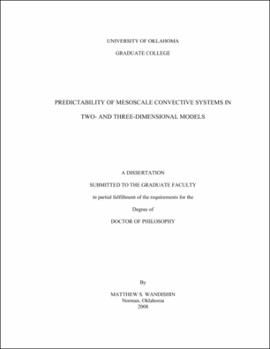| dc.contributor.advisor | Leslie, Lance | |
| dc.creator | Wandishin, Matthew | |
| dc.date.accessioned | 2019-04-27T21:39:11Z | |
| dc.date.available | 2019-04-27T21:39:11Z | |
| dc.date.issued | 2008 | |
| dc.identifier | 9954316602042 | |
| dc.identifier.uri | https://hdl.handle.net/11244/319267 | |
| dc.description.abstract | Mesoscale convective systems (MCSs) are a dominant climatological feature of the central United States and are responsible for a substantial fraction of warm season rainfall. Yet, very little is known about the predictability of MCSs. To help address this situation, a series of ensemble simulations of a MCS are performed using two- and three-dimensional versions of a storm-scale (Δx = 1 km) model and compared with an idealized control run. Ensemble member perturbations in wind speed, relative humidity and convective instability are based on current 24-h forecast errors from the North American Model (NAM). The ensemble results thus provide an upper bound on the predictability of mesoscale convective systems within realistic estimates of environmental uncertainty, assuming successful convective initiation. | |
| dc.description.abstract | The two-dimensional simulations are assessed by considering an ensemble member a success when it reproduces a convective system of at least 20 km in length (roughly the size of two convective cells) within 100 km on either side of the location of the MCS in the control run. By that standard, MCSs occur roughly 70% of the time for perturbation magnitudes consistent with 24-h forecast errors. Reducing the perturbations for all fields to one-half the 24-h error values increases the MCS forecast success rate to over 90%. The same improvement in forecast accuracy leads to a 30-40% reduction in maximum surface wind speed uncertainty, a roughly 20% reduction in the uncertainty in maximum updraft strength, and initially slower growth in the uncertainty in the size of the MCS. However, the occurrence of MCSs drops below 50% as the mid-layer mean relative humidity falls below 65%. The response of the model to reductions in forecast errors for convective instability, moisture, and wind speed is not consistent and cannot easily be generalized, but each perturbation type is found to have a substantial impact on forecast uncertainty. | |
| dc.description.abstract | Results from the three-dimensional simulations resemble those found in two dimensions. The MCS success rate for the three-dimensional runs is around 70% for perturbation magnitudes consistent with 24-h forecast errors, while reducing the initial uncertainty improves the success rate to nearly 85%. The maximum updraft and surface wind uncertainties are of similar magnitude to their two-dimensional counterparts. However, whereas the response of the model to improvements in the initial uncertainty is inconsistent in the two-dimensional experiment, it is non-existent in three-dimensions. For most storm features, improvement in the forecast uncertainty requires the reduction of initial uncertainty for all three of the fields together. The three-dimensional runs often produce solutions that resemble bow echoes, but surface winds associated with these solutions, and the perturbation profiles that produce them, are indistinguishable from the non-bowing solutions, making any conclusions about the bow-like systems difficult. | |
| dc.format.extent | 123 pages | |
| dc.format.medium | application.pdf | |
| dc.language | en_US | |
| dc.relation.requires | Adobe Acrobat Reader | |
| dc.subject | Convection (Meteorology) | |
| dc.subject | Mesometeorology | |
| dc.subject | Thunderstorms | |
| dc.title | Predictability of Mesoscale Convective Systems in Two- and Three-Dimensional Models | |
| dc.type | text | |
| dc.type | document | |
| dc.thesis.degree | Ph.D. | |
| ou.group | College of Atmospheric & Geographic Sciences::School of Meteorology | |
